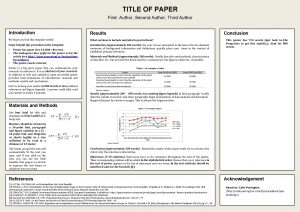PANDA Author Regina Galustyan The giant panda or







- Slides: 7

PANDA Author Regina Galustyan

The giant panda, or panda (Ailuropoda melanoleuca, literally meaning "black and white catfoot") is a bear native to central-western and south western China. It is easily recognized by its large, distinctive black patches around the eyes, over the ears, and across its round body. Though it belongs to the order Carnivora, the panda's diet is 99% bamboo. Pandas in the wild will occasionally eat other grasses, wild tubers, or even meat in the form of birds, rodents or carrion. In captivity they may receive honey, eggs, fish, yams, shrub leaves, oranges, or bananas along with specially prepared feed.

FOOD l l Bamboo is a group of perennial evergreens in the true grass family Poaceae, subfamily Bambusoideae, tribe Bambuseae. Giant bamboos are the largest members of the grass family. In bamboo, the internodal regions of the stem are hollow and the vascular bundles in the cross section are scattered throughout the stem instead of in a cylindrical arrangement. The dicotyledonous woody xylem is also absent. The absence of secondary growth wood causes the stems of monocots, even of palms and large bamboos, to be columnar rather than tapering.

PAW Despite its taxonomic classification as a carnivoran, the Giant Panda has a diet that is primarily herbivorous, which consists almost exclusively of bamboo. However, the Giant Panda still has the digestive system of a carnivore, as well as carnivore-specific genes, and thus derives little energy and little protein from consumption of bamboo. Its ability to digest cellulose is ascribed to the microbes in its gut. [The average Giant Panda eats as much as 9 to 14 kg (20 to 30 pounds) of bamboo shoots a day. Because the Giant Panda consumes a diet low in nutrition, it is important for it to keep its digestive tract full. The limited energy input imposed on it by its diet has affected the panda's behavior. The Giant Panda tends to limit its social interactions and avoids steeply sloping terrain in order to limit its energy expenditures.

Description Skull, as illustrated in Pocock's The Fauna of British India, including Ceylon and Burma - Mammalia Vol 2 A Giant Panda cub. At birth, the Giant Panda typically weighs 100 to 200 grams (3 1⁄2 to 7 oz) and measures 15 to 17 centimeters (6 to 7 in) long. The Giant Panda has a black-and-white coat. Adults measure around 1. 5 meters (5 ft) long and around 75 centimeters (2 ft 6 in) tall at the shoulder. Males can weigh up to 150 kilograms (330 lb). Females (generally 10– 20% smaller than males) can weigh up to 125 kilograms (280 lb). The Giant Panda has a body shape typical of bears. It has black fur on its ears, eye patches, muzzle, legs, arms and shoulders. The rest of the animal's coat is white. Although scientists do not know why these unusual bears are black and white, some speculate that the bold coloring provides effective camouflage into its shade-dappled snowy and rocky surroundings. The Giant Panda's thick, wooly coat keeps it warm in the cool forests of its habitat. The Giant Panda has large molar teeth and strong jaw muscles for crushing tough bamboo. The Giant Panda's paw has a "thumb" and five fingers; the "thumb" is actually a modified sesamoid bone, which helps the Giant Panda to hold bamboo while eating. Stephen Jay Gould used this example in his book of essays concerned with evolution and biology, The Panda's Thumb. The Giant Panda has the second longest tail in the bear family, with one that is 10 to 15 centimeters (4 to 6 in) long. The longest belongs to the Sloth Bear. The Giant Panda usually lives around 20 years in the wild and up to 30 years in captivity.

Behavior In the wild, the Giant Panda is a terrestrial animal and primarily spends its life roaming and feeding in the bamboo forests of the Qinling Mountains and in the hilly Sichuan Province. Though generally alone, each adult has a defined territory and females are not tolerant of other females in their range. Pandas communicate through vocalization and scent marking such as clawing trees or spraying urine. The Giant Panda is able to climb and take shelter in hollow trees or rock crevices but does not establish permanent dens. For this reason, pandas do not hibernate, which is similar to other subtropical mammals, and will instead move to elevations with warmer temperatures. Pandas rely primarily on spatial memory rather than visual memory. Social encounters occur primarily during the brief breeding season in which pandas in proximity to one another will gather. After mating, the male leaves the female alone to raise the cub.

Modern "discovery" The West first learned of the Giant Panda in 1869 because the French missionary Armand David received a skin from a hunter on March 11, 1869. The first Westerner known to have seen a living Giant Panda is the German zoologist Hugo Weigold, who purchased a cub in 1916. Kermit and Theodore Roosevelt, Jr. , became the first Westerners to shoot a panda, on an expedition funded Harkness became the first Westerner to bring by the Field Museum of Natural History in the 1920 s. In 1936, Ruth back a live Giant Panda, a cub named Su Lin who went to live at the Brookfield Zoo in Chicago. In 1938, five Giant Pandas were sent to London these activities were later halted because of wars and for the next half of the century, the West knew little of pandas.













